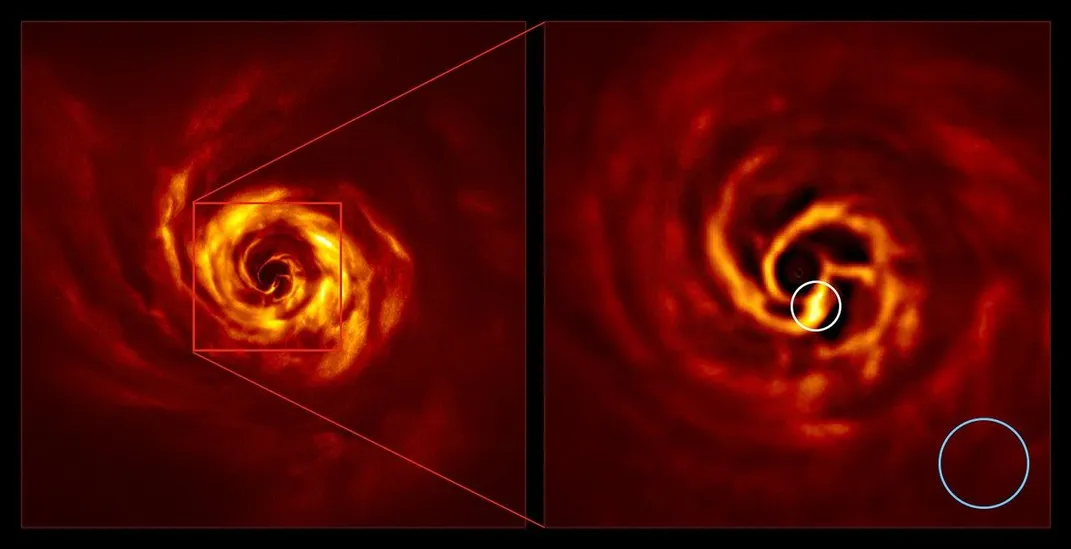This Very Large Telescope Snapped an Exoplanet’s Baby Photos
The fiery swirl looks like a “Doctor Who” title card, but it’s actually a photograph of a planet-in-progress 520 light year away
/https://tf-cmsv2-smithsonianmag-media.s3.amazonaws.com/filer/66/81/6681660d-4206-468d-b37a-95124b0b50bd/2020_may20_starswirl.jpg)
Congratulations, it’s a gas giant! An international team of astronomers has captured the telltale signs of the birth of an exoplanet for the first time.
The fiery image shows a swirl of dust and gas near the young star AB Aurigae, located in the Auriga constellation that’s visible to stargazers in the northern hemisphere in winter. Storms of thick dust and gas around a young star are prime real estate for planets to form, and previous observations saw hints that formation had started. In 2019 and early 2020, astronomer Anthony Boccaletti of PSL University in Paris led an international team at the European Southern Observatory’s Very Large Telescope in Chile to capture what may be the first photograph of exoplanet formation. Their results published this month in Astronomy and Astrophysics.
“Here, in this particular case, we don’t see the planet,” Boccaletti tells Becky Ferreira at Vice. “We see the structure that the planet produces on the spiral—this is what we call a twist.”

The twist is a thick point in the yellow spiral that’s vaguely lightning-bolt or S-shaped, located near the center of the photograph. Computer models of exoplanet formation have predicted that a twist like that might occur, but it hadn’t been observed directly until now. At the turning point of the twist, the dust changes direction from outward swirl to one that spins inward to the forming planet’s orbit, co-author Anne Dutrey of Astrophysics Laboratory of Bordeaux (LAB) in France explains in a statement.
“It was amazing,” University of Bordeaux astrophysicist Emmanuel Di Folco tells Science News’ Lisa Grossman. “It was exactly as we were expecting from the theoretical predictions of planet formation.”
The forming exoplanet is about the same distance from its star, AB Aurigae, as Neptune is from our sun, and it’s probably going to be a gas giant, not a rocky planet like Earth. Its star is also much younger than ours, only about four million years old, compared to the sun’s four and a half billion. “It’s really a baby,” Di Folco tells Science News.
The researchers got a clear look at the young star and its disc of dust by using an instrument called the Spectro-Polarimetric High-contrast Exoplanet Research, or SPHERE, which uses a coronagraph to block out the star itself and make the surrounding system visible. The same tool was used previously to find other very young exoplanets, but not one as early in the process as the newly found twist.
Scientists think that as the baby exoplanet spins and kicks the swirls of dust around it, it also incorporates some of the matter and grows.
“In this way, the planet accretes and accumulates the gas and it forms a huge envelope we see in the giant planets in our solar system,” like Jupiter or Saturn, Boccaletti tells Vice. “To build these atmospheres of gas, you really need something to bring the gas from somewhere and put it on the planet. This is the process we believe is working for these kinds of planets.”
Although the photos taken with SPHERE are the clearest yet of AB Aurigae and its dusty surroundings, the researchers don’t yet know for sure if the twist will lead to a new exoplanet. The team will continue to monitor the twist to make sure it’s moving with the speed and path expected from an exoplanet orbiting a star.
“This is the definitive way to prove that it actually corresponds to a massive object,” Boccaletti tells Robert Lea at the Startup. The team will also look for direct evidence that the possible planet is growing, “this way we could really measure the speed at which a planet forms and compare that to current models.”